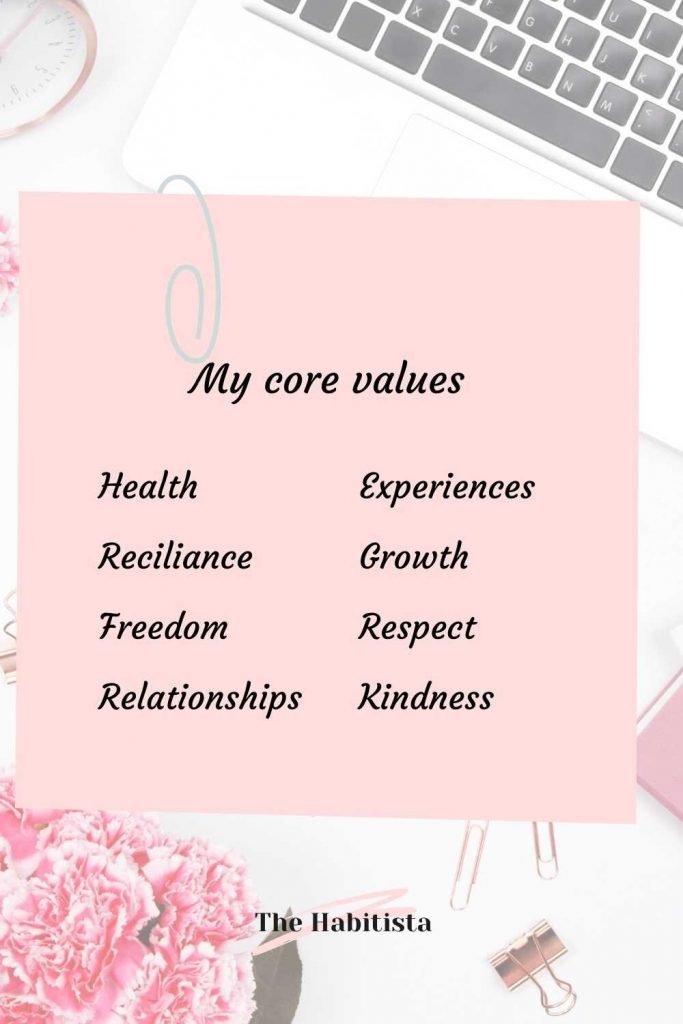This post may contain affiliate links. You can read my affiliate policy here.
Are you feeling stuck and don’t know how to change? Do you know what you should do, but actually doing it is easier said than done? That can all change, and in as little as one week! Commit one week to do these 7 inner work exercises and you will see significant changes in your outlook, your thinking, and ultimately, your life.

Why Do Inner Work Exercises?
Inner work is about changing from the inside out. It’s about challenging the thoughts and beliefs you have that are keeping you stuck in a reality that is no longer serving you.
There are many different ways of doing inner work. You can work with a therapist, coach or do the work on your own. There is no right or wrong way to do inner work, but there are ways that are more effective than others.
Here I have put together 7 inner work exercises that build on each-other and that can be the perfect introduction to kick-start your inner work if this is new to you, or a great complement to work you are already doing.
By going through and completing these inner work exercises you will take a close look at your current life and the trajectory you are on and look at possible futures depending on what choices you make today.
You will challenge any limiting beliefs that keeps you stuck, identify your personal core values, and set you up for a successful life moving forward. All within one week!
Are you ready to start changing your life?
Read More: The Inner Work to Do to Achieve Your True Goals
How to Do Inner Work
The best way to do these exercises is during the course of a week. It will be quite intense, but the benefits of an ‘inner work crash course’ will be worth it. Think about it as boot camp for your mind!
Set aside 30-60 minutes every day for a week. Decide beforehand when you will do these exercises: In the morning before work? After dinner? Just before bed? Make sure you pick a time where you can spend some time alone, uninterrupted.

If dedicating this kind of time on a daily basis is completely impossible, you can do the exercises every other, or every third day, but it is still important that you schedule time beforehand. The exercises build on each other and the momentum you will gain by doing the exercises regularly will propel you forward much quicker than if you just do the exercises ad-hoc.
As you go through these inner work exercises, it’s important not to just think about them, but to actually write it down. This is for two reasons: First, the exercises build on each other and you will want to be able to refer back to what you did on previous days. Second, when you write something down, you have to process it in a different way than when you just think about it. Put it into words. Being clear on what you are trying to say.
If you are afraid of someone finding what you write, use a password protected file, or go old-school with a diary with a lock!
Are you ready? Let’s get started.
Inner Work Exercises:
Day 1: Be a Time Traveller
Who will you be in 10 years’ time if you continue the path you are on today? Consider the areas of your life where you know you can do better but for some reason you haven’t so far.
Are you eating too much?
Spending too much?
Drinking too much?
Not exercising enough?
Stressing about work or family?
Close your eyes, take a few deep breaths and really think about what will happen if you continue this way. What will your life look like if you don’t change? Or even, if it gets worse?
- What will happen with your relationships and your family?
- Your finances?
- How will you feel? What will be the impact on your health?
- How will you spend your days? Your evenings?
Most of the exercises we will do this week will be positive, but it’s important to start with the baseline: What will happen if you don’t change?
Take your time thinking this through, using the questions above as prompts. Really feel what that life would be like if you continue down the path you are currently on. When you have a complete picture, write it down.

When you write it down, do it in the present tense. Use statements like ‘I am’ instead of ‘I will be’. Write as if you truly are a time traveller and you are writing this 10 years from now.
Remember, the writing down part is important! Don’t just think it through, pick up a pen or a keyboard and write down what your life will look like if you don’t change.
Day 2: Time Travel to a Better Life
Next, we will do a very similar exercise to yesterday, but this time we will imagine what life will be like in 10 years of we DO change.
What if you start eating a healthy diet?
Start spending your money, time and energy only on things you value?
Quit drinking or drink moderately?
Have a daily exercise habit?
Feel relaxed and content, rather than stressed out by life?
Close your eyes, take a few deep breaths and imagine your life if you make the changes you have thought about.
- What will happen with your relationships and your family?
- Your finances?
- How will you feel? What will be the impact on your health?
- How will you spend your days? Your Evenings?
Be specific, and consider what your life will look like, once you have changed the things you struggle with. Then write it down. It’s ok if you’re not great with words, just write down your thoughts, the images of you, thriving in life, after having made the changes you need.
Remember to again write in the present tense as if you were actually there - ‘I am’ instead of ‘I will’.
Now, go back to the Time Travelling exercise from yesterday. Read it and compare it with what you wrote today.
Is the discomfort of change worth it?
Which life would you rather live?
Day 3: Identify Your Personal Core Values
Most of us has a rough idea of what is important to us, but very few can tell you exactly what their core values are. However, specifying exactly what your personal core values are will help you as you move forward in life.
By having a defined list of core values that you have clear in your mind, they can guide your daily decisions in life, both the big decisions and the small decisions you do every day.

Is what I’m doing in line in my core values?
If not, it’s time to change direction.
By basing your decisions on your core values, you will start living more in line with yourself. You will create a life that is true to yourself and find contentment and happiness along the way.
Start by writing down anything that you think of that’s important to you. Family, integrity, growth… whatever it is. Don’t limit yourself, write down anything you can think of!
If you want some inspiration, download the free list of 50 core values below for inspiration!
Now that you have a list of things that are important to you, start limit them down to somewhere between 6 and 12. Highlight the values that speaks to you the most and write out a list with these values and put it somewhere that you can see it every day.
On your desk?
By the mirror in your bathroom?
Read More: Listing Your Personal Core Values Will Help Guide Your Choices
Day 4: Challenge Your Limiting Beliefs
We all have beliefs that we have learned throughout our lives. Some beliefs serve us well, others may lose their usefulness as we grow and change. However, if we never take a good look at our beliefs, we risk carrying with us limiting beliefs that, at best, no longer serve us. And at worst, are now a hindrance for the life we want to live.
Go back to the time traveller exercises from day one and two and think about the changes you would need to make you get the future you wish for on day two.
Why have you not done them yet?
Most likely because a part of you feel that you are getting something out of them.
Take alcohol for example, if you want to cut down on your drinking but haven’t, you probably have a number of beliefs about why you drink:
- It relaxes me
- I’m more social when I drink
- My friends wouldn’t spend so much time with me if I don’t go out drinking with them
- I need a drink to wind down after work
- Wine is my reward for getting through the work week
Write down your own reasons for continuing life as it is? To continue to spend, eat, not exercise, or work too much.
Challenge Your Limiting Beliefs
Now look at each belief in turn. Is this belief really serving it’s purpose? Is it the way you want to do things?
If you are looking to change your drinking, consider if the drink really serving this purpose? If you are drinking too much, do your friends really like you better when you drink? And if so, are these friends you want to have in your life, that fit into the new life you are creating?
The glass of wine may be relaxing after work but is the second or third class equally relaxing? And are you still feeling relaxed when you wake up at 4 am with anxiety because you had too much to drink?
Go through your list of reasons for continuing life as it is and write down the arguments for why these arguments are not true. Or why there may be a more beneficial way to get the same outcome.
Finally, write down your new beliefs:
- Wine does not relax me long term, the short-term feeling of relaxation is soon replaced by anxiety and regret.
- My real friends prefer to spend time with me sober.
Whatever it is you are trying to change, examine if your current beliefs are truly serving you. Examine if they are still true, and if they are the beliefs you want to take with you into your new life.

Day 5: Craft a Mental Image
You have now taken a close look at your future life. You have identified your personal core values and challenged your limiting beliefs. This is powerful stuff. The next step is to create a mental image of your new life that you can recall at any time.
This mental image will be your very personal reminder of what you are trying to achieve. Something you can quickly pull up when you are making decisions, or when you are considering taking steps that are not in the direction you truly want to go.
To create this mental image, start with going back and read what you wrote on Day 2 when you time travelled to a better life. Then, also read your core values and your new beliefs.
With this new you clearly in mind close your eyes, take a few deep breaths, and try to imagine living this life.
Create a clear and detailed picture in your mind of what this life would look like, a snapshot if you will, of a great moment in this new life.
Spend some time really examining this picture and committing it to memory.
Once that’s done, you need to practice recalling this picture throughout the day. Decide on a specific time of day when you are going to recall the image and set yourself a reminder. It may be a reminder on your phone, a post-it on your bathroom mirror or by your desk.
The important thing is that for the next week, you actively recall this image a couple of times a day. This way, the image will become ingrained in your mind, and you can easily recall it in the future when you need a reminder of where you’re going.
When you reach for the donuts, drink, or stress out over work, you will pull up this mental image, to remind yourself of the greater plan, to remember why change is worth it.

Day 6: Write Your Mission Statement
You have already completed 5 out of 7 inner work exercises – well done! Today we are going to pull everything you have learned about yourself together and write your mission statement.
A mission statement is a short sentence or paragraph, explaining who you are going to be and what you are going to do. It encompasses your personal core values and what you consider success.
Having a personal mission statement will help guide your choices, and your life, moving forward, and will help your reach your goals.
How to create a personal mission statement:
- Go back to when you time travelled to a better life. What had you achieved? What is it that, by achieving it, you will truly feel successful?
- Go back to your personal core values and consider, what will be the most important core value(s) that you will need to bring with you as you reach success?
- Write a sentence (or two) combining your core values and your success. If you can, start the sentence with ‘I am’

Personal Mission Statement Template
If you need help to put your mission statement together, try using this template as a starting point, but feel free to change it up so it feels right for you.
‘I am …(your goal, what you want to achieve, do, or become)… because / to be able to…(the reason why it’s important). I achieve this by…. (the core values / most important actions to get you there).’
For example:
‘I am living healthily to be able to fully enjoy my life as I get older, having the energy to play with my great great grandchildren. I achieve this by eating healthily most of the time, while still allowing myself the odd indulgent treat.’
Spend some time working on your mission statement. Then put it away. Finally, decide on a time when you will review your mission statement to see if it still feels right or if you want to do any additional tweaks.
You may want to keep it in your bedside table and review it before you go to bed. That way your subconscious will work on it through the night which will both motivate you, and help you make any notes or adjustments in the morning.
Once you are happy with your mission statement, keep it somewhere you can see it regularly to remind you on this new, great path you are on.
Remember, a mission statement can, and should, evolve with you. If after some time you feel that it’s time to update your mission statement, do so.

Day 7: Harness the Power of Affirmations
This final exercise is to give you the tools to continue working on your new beliefs, and to help your mind continue to change to, and accept, the new reality you are creating.
If you are not used to affirmations, they may feel a bit out there, but I suggest you give it a try anyway. I expect you will be positively surprised!
We have spent the past week (or however long you took to complete these inner work exercises) working on change, and that is a great start, but now we need to continue to work on really cementing those learnings into your subconscious.
And the best tool to do that? Affirmations. Positive statements about yourself that you repeat daily until you truly believe them, consciously and subconsciously.
Affirmations are an especially good tool if you are prone to negative self-talk. It helps balance things, making sure that you say positive things to yourself, in addition to the inner monologue of trash talk that’s a bad habit many of us struggles with.
How to Create Effective Affirmations
- Your new beliefs are a great inspiration for your affirmations. You may also want to reflect on your time traveling to a better life, your core values and your mission statement.
- An affirmation should be positive. It should focus on what you want to do or become. Not what you don’t want.
Example: ‘I am living a healthy life and exercising regularly.’ Instead of ‘I am no longer a couch potato’.
- Use the present tense; write the affirmation as if you have already achieved them.
Example: ‘I am good at managing my money’ not ‘I will be good at managing my money’.
- Make the sentence short and snappy, easy to remember.
- Be realistic. You need to be able to believe that what you are saying is achievable. If your subconscious completely rejects the affirmation, it won’t work.
Example: ‘I am a billionaire’ may be less effective than ‘I am attracting and abundance of wealth’.
- Finally, make sure you are kind to yourself. Don’t use your affirmations to push yourself into unhealthy behaviours where you are overdoing a good thing to the detriment of your health.

How to Use Affirmations to Maximum Effect
Start by picking one affirmation. As we want to use the affirmation to change the subconscious, we need to be consistent over time. Start by committing to the affirmation for one month, but you may well want to continue for two or three months, to make sure it has really sunk in.
For maximum effect, you will want to say the affirmation out loud, so pick a time and place every day when you have the privacy to do that. It will feel awkward at first, so you will want to have some space to yourself.
Pick a place with a mirror, so you can look yourself in the eyes as you say your affirmation. Good places might be the bathroom or the car.
If you already have a yoga or meditation practise, that’s another great place to do your affirmations.
Make sure you say the affirmation minimum once a day. If you need to, put a post-it by the mirror to remind you!
Congratulations, You have Completed All 7 Inner Work Exercises!
Doing these inner work exercises will have kick-started your path toward change but remember that you still need to continue to do the work to forge your new path.
Continue Your Inner Work Exercises
You still have work to do, practising recalling your mental image, reviewing your personal mission statement, and doing your affirmations. It is critical that you continue these exercises for long term success.
It’s also recommended that you come back regularly to review what you wrote down as you completed these exercises. How about setting a reminder in your calendar on a monthly basis? Take a few minutes to review what you wrote and note down if anything has changed since.
Do you need to update your mission statement or is it time for a new affirmation?
Finally, you may also want to bookmark this page and come back to it in months or years to re-do all, or some, of the exercises in order to get you back on track or take your development to the next step.
Read More
How to Make Yourself a Priority – Not Just an Option
Do Your Habits Deplete Your Personal Resources?
Accountability to Yourself: How and Why it’s Important
Habits to Improve Your Life: The Ultimate Guide
How to Make a (Useful) List of Your Personal Resources
Book Tip

For more tips, check out the Resources for Personal Development page.

Leave a Reply